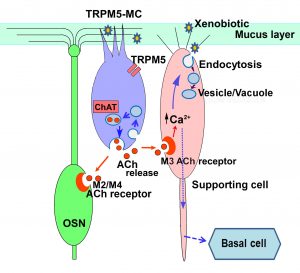Important role of sensory system
Humans and animals rely on sensory systems to learn about the environment and to guide daily life and survival.
Chemical sensory systems in the nose
In the nose of vertebrates, sensory neurons of the olfactory system detect thousands of chemical substances and provide sensory guidance for selecting suitable habitats, foods and mates, social interaction and predator avoidance.

The nose also houses the trigeminal sensory system, which responds to potentially harmful chemical substances including odorous irritants, pollutants, and bacterial substances and initiates common chemical senses, such as irritation and pain.
This type of trigeminal activation signals the danger of potential chemical insults to the nose, trachea and lungs and triggers protective reflexes, such as runny nose, coughing and sneezing.
Some of the trigeminal nerve fibers are synaptically connected to the solitary chemosensory cells (SCCs), which play an important role in detecting irritating, harmful chemicals, bacterial substances and nasal inflammation and health.

Outcome from chemical senses deficits in the nose
Abnormal olfactory and trigeminal chemosensation reduces the quality of life and is closely associated with respiratory diseases and brain disorders such as rhinitis, asthma, Alzheimer’s, and Parkinson’s diseases.
Our research focus
We are interested in mechanisms underlying chemosensory activation, plasticity, modulation and the negative impact of environmental exposure.
In our study, we use transgenic and genetic knockout mice as our animal model and multiple experimental approaches including intracellular Ca2+ imaging, electrophysiological recordings, immunolabeling and molecular analyses and behavioral assays.
Our goal is to provide knowledge about sensory activity of selected chemical agents, adaptive plasticity and modulatory networks that maintain sensory functions under various environmental conditions. In doing so, we hope to increase our understanding of important factors contributing to sensory maintenance, dysfunction and nasal illnesses.
Current Projects
Project 1. Health impacts of electronic cigarette (e-cig) constituents
This project aims to understand the health effects and toxicity associated with e-cig exposure on the upper respiratory passageway, including nasal chemosensory and epithelial functions, and subsequent implications for e-cig user behavior.
The nasal mucosae include both sensory and respiratory epithelia and play diverse and important roles, including monitoring air quality, initiating protective reflexes, and removing harmful substances from the inspired air. Additionally, the nasal surface barrier prevents toxicants and infectious agents from entering the brain via the olfactory route, which can lead to brain disorders. Perturbed nasal structure and functions, including olfactory dysfunction, trigeminal hypersensitivity, epithelial tissue damage and remodeling are commonly found in chronic respiratory diseases associated with environmental exposure.
We are investigating sensory activation and alteration by short and long-term exposure of e-liguid flavorants and other constituents using a combination of approaches. The goal of this project is to better understand the complex health and behavioral impacts of e-cig exposure.

Project 2. TRPM5-MCs and the cholinergic network in the olfactory epithelium and their role in maintaining olfactory functions
The sense of smell is initiated by the main olfactory epithelium (MOE), which also provides surface lining for a significant portion of the nasal mucosa and additionally serves important roles in xenobiotic metabolism and epithelial defense. The MOE is in constant contact with the external chemical environment. Chronic exposure to air pollutants and odor irritants causes olfactory dysfunction, respiratory illnesses and neurodegenerative diseases, but their initial pathophysiological changes are poorly understood.
The MOE mainly consists of olfactory sensory neurons (OSNs), supporting cells (SCs), microvillous cells (MCs) and basal cells, which differ in morphology and functions. However, mechanisms coordinating MOE multicellular network for functional maintenance are understudied, presenting a significant gap in our knowledge. Our overarching research goal is to increase our mechanistic understanding of MOE modulatory network and its relationship to olfactory and airway diseases.
We previously identified and characterized a population of transient receptor potential M5-expressing MCs (TRPM5-MCs) in the MOE. TRPM5-MCs are chemo-responsive and capable of synthesizing and releasing acetylcholine (ACh). We also showed that ACh modulates activities of isolated SCs and OSNs via different muscarinic ACh receptors (AChRs). These early studies discovered an intrinsic cholinergic network in the MOE. We further showed that TRPM5-MCs play an important role in maintaining odor responses, olfactory-guided behavior of food searching, and social and sexual odor preference in a challenging chemical environment. We are investigating the underlying mechanisms and direct involvement of the cholinergic network in TRPM5-MC-mediated adaptive protection and knowledge of signaling components downstream of ACh receptors.
The goal of this project is to provide mechanistic understanding of MOE protective maintenance so that a solid foundation can be laid for studies of environmental-exposure-associated disorders, facilitating therapeutic interventions.
